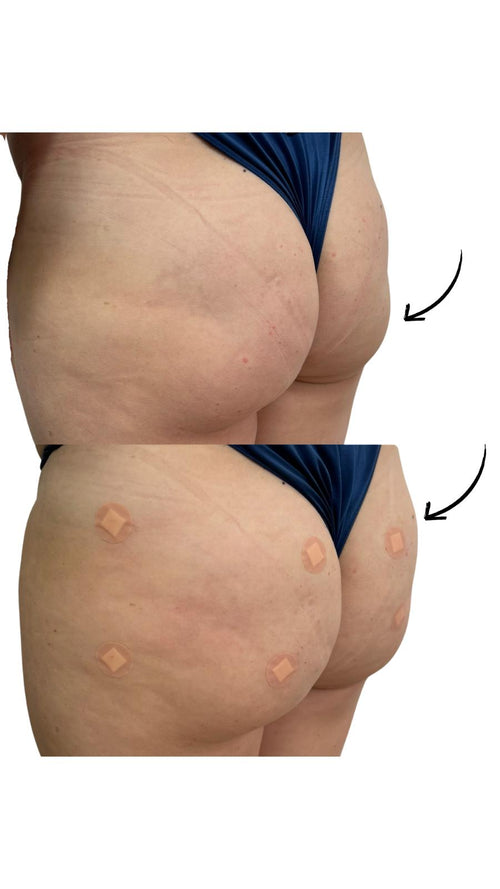Non-Surgical Bum Lift (BBL) with PLLA at It’s Me & You Clinic.
Material Consumption and Waste Generation

Material consumption and waste generation are significant contributors to the environmental impact of non-surgical aesthetic procedures. These procedures often rely on single-use products, specialized equipment, and packaging materials that contribute to resource depletion and pollution.
Ingredients in cosmetic injectables, fillers, and topical creams can also have environmental consequences.
Here’s a breakdown:
- Material Consumption:
- Syringes and needles for injectables.
- Disposables applicators and containers for topical products.
- Specialized equipment like lasers, radiofrequency devices, and ultrasound machines.
- Packaging materials for ingredients, finished products, and medical supplies.
- Waste Generation:
- Sharps waste (needles, syringes) requiring proper disposal to prevent infections.
- Packaging materials, which may be recyclable but often end up in landfills.
- Chemical waste from used solutions and expired products.
- Ingredients:
- Chemicals: Certain chemicals used as preservatives, stabilizers, or active ingredients may be toxic to aquatic life or contribute to air pollution during production.
- Biodegradable fillers: While marketed as environmentally friendly, their long-term effects on ecosystems are still being studied.
- Plant-based extracts:** Sourcing these sustainably is crucial to avoid deforestation and habitat loss.
- Packaging:
Non-surgical procedures consume a variety of materials, including:
These materials often come from non-renewable resources and their production involves energy-intensive processes.
Non-surgical aesthetic procedures generate various types of waste:
Some ingredients commonly used in aesthetic procedures can have environmental impacts:
Packaging for aesthetic products often uses non-biodegradable materials like plastic, contributing to plastic pollution.
Reserve a Dermal Filler Consultation with Dr. Laura Geige Now
Minimalist packaging, using recycled and recyclable materials, and refillable options can help minimize this impact.
Material consumption and waste generation are significant concerns associated with non-surgical aesthetic procedures. These procedures often involve single-use plastic packaging for products, disposable applicators, and other consumables.
The sheer volume of these materials can contribute to landfill accumulation and environmental pollution.
Disposal concerns arise from the potential presence of hazardous chemicals in some aesthetic product ingredients or byproducts. Improper disposal can contaminate soil and water sources, posing risks to human health and ecosystems.
Biodegradability is a crucial factor in mitigating the environmental impact. Unfortunately, many materials used in aesthetic procedures are not readily biodegradable. They persist in the environment for extended periods, leaching harmful substances and disrupting natural processes.
The use of environmentally friendly packaging alternatives, such as recyclable or compostable options, can help reduce waste. Encouraging the adoption of reusable tools and equipment is another important step.
Promoting responsible disposal practices, including proper recycling and hazardous waste management, is essential to minimize environmental harm.
Furthermore, research and development of biodegradable materials specifically for aesthetic applications could significantly contribute to a more sustainable future for this industry.
Dr. Laura Geige specializes in Brazilian Butt Lift (BBL) artistry.
Energy Usage and Carbon Footprint
Energy usage and carbon footprint are significant contributors to the environmental impact of non-surgical aesthetic procedures. These procedures often involve complex machinery, sophisticated technologies, and extensive manufacturing processes, all of which consume considerable amounts of energy and generate greenhouse gas emissions.
Production Processes:
- Device Manufacturing: The production of aesthetic devices, such as lasers, radiofrequency generators, and ultrasound machines, requires substantial energy input for mining raw materials, refining components, assembling devices, and conducting quality control testing.
- Ingredient Synthesis: Many non-surgical procedures utilize injectables, creams, or serums containing active ingredients. The synthesis of these ingredients often involves complex chemical reactions that require significant energy consumption and may release harmful byproducts.
- Packaging and Transportation: Packaging materials for aesthetic devices, consumables, and products are typically manufactured from petroleum-based plastics or other resource-intensive materials. Additionally, the transportation of these goods from manufacturers to clinics and consumers contributes to fuel consumption and emissions.
Energy Consumption in Clinics:
- Device Operation: Aesthetic devices typically require a constant supply of electricity to power their intricate systems. The continuous operation of these devices, especially during extended treatment sessions, can lead to significant energy consumption.
- Lighting and HVAC: Clinics providing aesthetic treatments often have specialized lighting needs and temperature-controlled environments for patient comfort. These factors contribute to increased energy demand for heating, ventilation, and air conditioning (HVAC) systems.
Reducing Environmental Impact:
- Sustainable Manufacturing Practices: Implementing eco-friendly manufacturing processes, such as using renewable energy sources, reducing waste generation, and employing sustainable packaging materials, can minimize the environmental footprint of aesthetic devices and products.
- Energy-Efficient Devices: Investing in energy-efficient aesthetic technologies that consume less electricity during operation can significantly reduce energy consumption in clinics.
- Responsible Waste Management: Proper disposal of medical waste generated from aesthetic procedures, including sharps, packaging, and contaminated materials, is crucial to prevent environmental contamination and promote recycling where possible.
Energy usage and carbon footprint are significant concerns in the context of non-surgical aesthetic procedures. These procedures often involve sophisticated equipment, such as lasers, radiofrequency devices, and microdermabrasion machines, all requiring substantial electricity to operate.
The energy consumption associated with these devices contributes to greenhouse gas emissions, exacerbating climate change. Furthermore, the production and disposal of single-use consumables, like needles and applicators, further amplify the environmental impact by adding to landfill waste and potentially releasing harmful toxins during decomposition.
Transportation plays a crucial role in the overall carbon footprint of non-surgical aesthetic procedures. Patients often travel to clinics for consultations and treatments, contributing to vehicle emissions. Additionally, the transportation of equipment, supplies, and personnel involved in manufacturing and delivering these procedures also adds to the environmental burden.
Infrastructure requirements for non-surgical aesthetic clinics further contribute to energy consumption and carbon footprint. These facilities require substantial heating, cooling, and lighting systems, all of which rely on energy sources that often involve fossil fuels.
Moreover, the construction materials used in building these clinics can have a significant environmental impact, depending on their source and manufacturing processes. Sustainable practices, such as using recycled materials and renewable energy sources, can help mitigate these impacts.
Impact on Water Resources
The non-surgical aesthetic industry, while seemingly focused solely on enhancing appearance, carries significant implications for water resources and consumption patterns within production processes.
One major contributor to this impact is the manufacturing of cosmetic ingredients and products. The synthesis and processing of various chemicals, polymers, and fillers often involve intensive water usage in cleaning, cooling, and dilution steps.
Furthermore, the packaging materials used for these products, such as plastic bottles and containers, require substantial amounts of water for their production.
Here’s a breakdown of specific impacts:
- Ingredient Production: Many cosmetic ingredients are derived from natural sources that require vast quantities of water for cultivation or extraction. For instance, hyaluronic acid, a popular filler, is often produced using genetically modified bacteria that need significant water resources.
- Chemical Synthesis: The chemical reactions involved in synthesizing ingredients like Botox and other neurotoxins consume considerable amounts of water for solvent use and process control.
- Manufacturing Processes: Cleaning and sanitation procedures within production facilities require substantial water usage to maintain hygiene standards.
- Packaging Materials: Plastic packaging, prevalent in the cosmetic industry, necessitates large water inputs during its manufacturing process.
The disposal of used products and packaging also contributes to the water burden. Improper disposal can lead to pollution of waterways with harmful chemicals and microplastics.
Addressing these challenges requires a multi-pronged approach:
- Sustainable Sourcing: Promoting the use of sustainably sourced ingredients, minimizing reliance on water-intensive crops or extraction methods.
- Water-Efficient Manufacturing: Implementing water conservation measures within production facilities, such as recycling and reusing water, optimizing processes, and adopting water-efficient technologies.
- Minimalist Packaging: Reducing packaging materials and promoting reusable or biodegradable alternatives.
- Consumer Responsibility: Encouraging responsible disposal practices to prevent contamination of water sources.
By acknowledging the hidden water footprint of non-surgical aesthetics and actively pursuing sustainable solutions, we can strive for a more environmentally responsible industry.
Non-surgical aesthetic procedures, while popular for their minimally invasive approach and rapid results, can have a significant impact on water resources, wastewater treatment, and contamination.
One primary concern is the disposal of used products and materials associated with these procedures. Hyaluronic acid fillers, commonly used in treatments like lip augmentation and wrinkle reduction, are biodegradable but require proper disposal to prevent environmental harm. If not handled correctly, they can contaminate water sources through improper waste management practices.
Similarly, chemical peels and microneedling utilize various solutions and serums that may contain ingredients potentially harmful to aquatic life if released into wastewater systems. These chemicals can disrupt aquatic ecosystems, leading to imbalances in species populations and potential long-term ecological damage.
Moreover, the increased demand for water driven by these procedures raises concerns about water scarcity in some regions. Many treatments require thorough cleansing and rinsing steps, contributing to water consumption even when performed at home.
Wastewater treatment facilities face additional challenges processing the waste generated by aesthetic procedures. Specialized filtration systems may be required to remove microplastics from exfoliating scrubs or other microbead-containing products, ensuring that these particles don’t contribute to plastic pollution in waterways.
The potential for contamination extends beyond the immediate disposal of materials. Improper sterilization practices can lead to the spread of infectious agents through contaminated equipment. This poses a risk not only to patients but also to wastewater treatment workers handling potentially infected waste.
Addressing these environmental impacts requires a multifaceted approach involving responsible manufacturing, proper waste management protocols, and public awareness campaigns highlighting the importance of sustainable practices within the aesthetics industry.
Ayiti Natives I Like Corbyn But Emily Patricia Fae MS Style and Grace
- Understanding Breadcrumbing In The Age Of Modern Dating - June 4, 2025
- Navigating Open Relationships: Building Trust And Communication - June 4, 2025
- The Environmental Impact Of Non-Surgical Aesthetic Procedures - June 3, 2025
